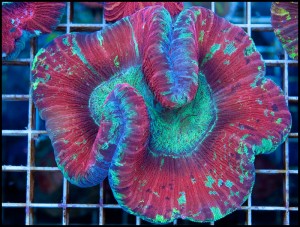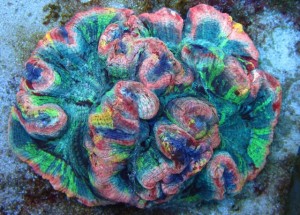The most popular coral species in our hobby usually have an outstanding diversity of color patterns. Zoanthids seem to have a limitless number of “morphs” and color variations that hobbyists enjoy collecting and trading. Acanthastrea also appear to have an almost endless variety of colors.
“Open brain” corals of the genus Trachyphyllia (Trachyphyllia geoffroyi and Wellsophyllia radiata) also have a huge variety of color variation. The most common colors are red and green. Color patterns are widely dependent on collection depth and area. Most specimens are collected in Indonesia, and smaller numbers from Australia.
Less typical colors in Trachyphyllia are blues, yellows, oranges, and pinks. These color variations typically command a higher price. Very ordinary Trachyphyllia can sometimes develop rainbow coloration after several months under aquarium lighting.
To achieve top color and health in Trachyphyllia, I recommend the following care:
- Keep your brain on the sand or tank bottom. This is important for quite a few reasons. As the coral expands and inflates, keeping it on rock can cause tears in the fleshy tissue. This can lead to infection and recession of the tissue from the skeleton. These corals are naturally found on sand or silty mud substrates.
- Keep the light levels low to moderate. Trachyphyllia are very commonly imported with moderate bleaching from too much light exposure in holding tanks along the route to your tank. By following step #1 you will already be doing the coral a favor with less direct light. Corals acclimated to aquarium lighting for several months can tolerate higher light levels than new specimens.
- Low flow. These corals are not sitting on the reef next to Acropora colonies getting hammered with flow! Too much flow will prohibit polyp expansion. The tissue will stay tightly contracted against the skeleton.
- Feed ME! Brain corals love to eat any meaty foods, once a week if you can. Place food directly on the coral and turn off the pumps for 30 minutes to one hour. A feeding bell can be constructed out of a 2 liter pop bottle to prevent aggressive shrimp and crabs from stealing the food.
I’ve also noticed blue lighting (from actinic/blue fluorescent lighting or LED) in combination with low flow and indirect light has the biggest effect on an ordinary specimen turning into a real eye catcher.
Australian specimens coming into the hobby are quite different from the Indonesian specimens. They are typically smaller and do not inflate their tissues as much as Indo brains. Colors are typically very bright green/yellow and a more muted array of green, yellow, and brown.














0 Comments